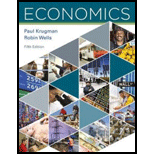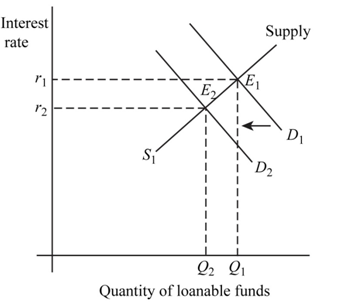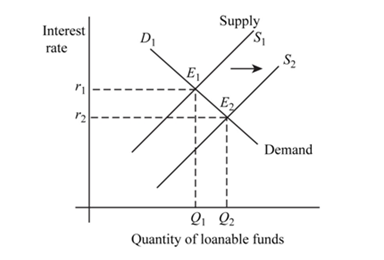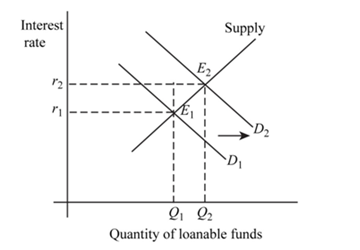
To determine: What happens to private savings, private investment spending and the investment rate in the given scenario.
Concept Introduction:
Closed Economy: It is a type of economy in which there is no external trade that means there is no import and export.
Investment spending: All those spending which are done on physical capital which means that only expenses that increase economy level of physical capital is known as investment spending.
The formula to calculate investment spending is:

Here,
- I is investment spending.
- GDP is
gross domestic product . - C is consumption spending.
- G is government spending.
Private Saving: It is the saving made by people for times of emergency or bad financial conditions in the future.
The formula to calculate private saving is:

Here,
- T is tax revenue.
- GDP is gross domestic product.
- C is consumption spending.
Budget Balance: The budget is considered to be balanced when revenue collected from tax and expenditures made by government are equal. When it is deficit it is represented by a negative value, when it is surplus it is represented by a positive value and in case of balanced budget it is zero.
Loanable Funds Market: It is an imaginary market which illustrates the market result of the
Demand for Loanable Funds: It is represented by a downward sloping curve which shows that as the interest rate increases the demand for such funds decreases and vice versa.
Supply for Loanable Fund: It is represented by the s curve that slopes upward which means that as the interest rate increases the supply of such fund also rises and vice versa.
Explanation of Solution
a. Budget balance is zero.

Fig 1
- In the above figure, vertical axis shows interest rate and horizontal axis shows quantity of loanable funds.
 and
and represents demand and supply curve for loanable funds respectively. The intersection of demand and supply curve gives equilibrium point
represents demand and supply curve for loanable funds respectively. The intersection of demand and supply curve gives equilibrium point  where the interest rate is
where the interest rate is  and quantity of funds is
and quantity of funds is 
- Due to reduction in deficit the demand curve will shift from
 to
to There is no change in supply curve. The new equilibrium is achieved at point
There is no change in supply curve. The new equilibrium is achieved at point  where the new interest rate is
where the new interest rate is and. quantity of fund demanded is
and. quantity of fund demanded is  Hence, interest rate as well as quantity of loanable fund decreases at new level of equilibrium.
Hence, interest rate as well as quantity of loanable fund decreases at new level of equilibrium. - Due to decrease in interest rate and income, private savings will decrease as the
opportunity cost of saving has decreased. Private investment spending will increase because at lower interest rate people will borrow more to invest.
Conclusion:
Thus, private saving and interest rate decreases and private investment spending increases.
b. Consumers save more.

Fig 2
- In the above figure, vertical axis shows interest rate and horizontal axis shows quantity of loanable funds.
 and
and represents demand and supply curve for loanable funds respectively. The intersection of demand and supply curve gives equilibrium point
represents demand and supply curve for loanable funds respectively. The intersection of demand and supply curve gives equilibrium point  where the interest rate is
where the interest rate is  and quantity of funds is
and quantity of funds is 
- Due to increase in saving by consumer supply curve will shift from
 to
to There is no change in demand curve. The new equilibrium is achieved at point
There is no change in demand curve. The new equilibrium is achieved at point  where the new interest rate is
where the new interest rate is and. quantity of fund demanded is
and. quantity of fund demanded is Hence, interest rate has decreased and quantity has increased at new level of equilibrium.
Hence, interest rate has decreased and quantity has increased at new level of equilibrium. - Due to decrease in interest rate private savings will decrease as the opportunity cost of saving has decreased and due to increase in output income will increase which will induce more saving.
- Hence, savings will increase or decrease, this cannot be concluded. Private investment spending will increase because at lower interest rate people will borrow more to invest.
Conclusion:
Thus, interest rate decreases and private investment spending increases. Private saving may decrease or increase.
c. Businesses become optimistic for future profitability.

Fig 3
- In the above figure, vertical axis shows interest rate and horizontal axis shows quantity of loanable funds.
 and
and represents demand and supply curve for loanable funds respectively. The intersection of demand and supply curve gives equilibrium point
represents demand and supply curve for loanable funds respectively. The intersection of demand and supply curve gives equilibrium point  where the interest rate is
where the interest rate is  and quantity of funds is
and quantity of funds is 
- Businesses are optimistic about future profitability which means that the investment will increase. This will lead to rise in demand for loanable fund. As a result the demand curve will shift from
 to
to
- There is no change in supply curve. The new equilibrium is achieved at point
 where the new interest rate is
where the new interest rate is Hence, interest rate as well as quantity of loanable fund increases to a new level of equilibrium.
Hence, interest rate as well as quantity of loanable fund increases to a new level of equilibrium. - Due to an increase in interest rate, income private savings will increase as the opportunity cost of saving has increased. Private investment spending will decrease because at higher interest rate people will borrow less to invest.
Conclusion:
Thus, private saving and interest rate increases and private investment spending decreases.
Want to see more full solutions like this?
- Styrofoam is non-biodegradable and is not easily recyclable. Many cities and at least one state have enacted laws that ban the use of polystyrene containers. These locales understand that banning these containers will force many businesses to turn to other more expensive forms of packaging and cups, but argue the ban is environmentally important. Shane owns a firm with a conventional production function resulting in U-shaped ATC, AVC, and MC curves. Shane's business sells takeout food and drinks that are currently packaged in styrofoam containers and cups. Graph the short-run AFC0, AVC0, ATC0, and MC0 curves for Shane's firm before the ban on using styrofoam containers.arrow_forwardd-farrow_forwarda-c pleasearrow_forward
- d-farrow_forwardPART II: Multipart Problems wood or solem of triflussd aidi 1. Assume that a society has a polluting industry comprising two firms, where the industry-level marginal abatement cost curve is given by: MAC = 24 - ()E and the marginal damage function is given by: MDF = 2E. What is the efficient level of emissions? b. What constant per-unit emissions tax could achieve the efficient emissions level? points) c. What is the net benefit to society of moving from the unregulated emissions level to the efficient level? In response to industry complaints about the costs of the tax, a cap-and-trade program is proposed. The marginal abatement cost curves for the two firms are given by: MAC=24-E and MAC2 = 24-2E2. d. How could a cap-and-trade program that achieves the same level of emissions as the tax be designed to reduce the costs of regulation to the two firms?arrow_forwardOnly #4 please, Use a graph please if needed to help provearrow_forward
- a-carrow_forwardFor these questions, you must state "true," "false," or "uncertain" and argue your case (roughly 3 to 5 sentences). When appropriate, the use of graphs will make for stronger answers. Credit will depend entirely on the quality of your explanation. 1. If the industry facing regulation for its pollutant emissions has a lot of political capital, direct regulatory intervention will be more viable than an emissions tax to address this market failure. 2. A stated-preference method will provide a measure of the value of Komodo dragons that is more accurate than the value estimated through application of the travel cost model to visitation data for Komodo National Park in Indonesia. 3. A correlation between community demographics and the present location of polluting facilities is sufficient to claim a violation of distributive justice. olsvrc Q 4. When the damages from pollution are uncertain, a price-based mechanism is best equipped to manage the costs of the regulator's imperfect…arrow_forwardFor environmental economics, question number 2 only please-- thank you!arrow_forward
- For these questions, you must state "true," "false," or "uncertain" and argue your case (roughly 3 to 5 sentences). When appropriate, the use of graphs will make for stronger answers. Credit will depend entirely on the quality of your explanation. 1. If the industry facing regulation for its pollutant emissions has a lot of political capital, direct regulatory intervention will be more viable than an emissions tax to address this market failure. cullog iba linevoz ve bubivorearrow_forwardExercise 3 The production function of a firm is described by the following equation Q=10,000-3L2 where L stands for the units of labour. a) Draw a graph for this equation. Use the quantity produced in the y-axis, and the units of labour in the x-axis. b) What is the maximum production level? c) How many units of labour are needed at that point? d) Provide one reference with you answer.arrow_forwardExercise 1 Consider the market supply curve which passes through the intercept and from which the market equilibrium data is known, this is, the price and quantity of equilibrium PE=50 and QE=2000. Considering those two points, find the equation of the supply. Draw a graph of this line. Provide one reference with your answer. Exercise 2 Considering the previous supply line, determine if the following demand function corresponds to the market demand equilibrium stated above. QD=3000-2p.arrow_forward

 Principles of Economics (12th Edition)EconomicsISBN:9780134078779Author:Karl E. Case, Ray C. Fair, Sharon E. OsterPublisher:PEARSON
Principles of Economics (12th Edition)EconomicsISBN:9780134078779Author:Karl E. Case, Ray C. Fair, Sharon E. OsterPublisher:PEARSON Engineering Economy (17th Edition)EconomicsISBN:9780134870069Author:William G. Sullivan, Elin M. Wicks, C. Patrick KoellingPublisher:PEARSON
Engineering Economy (17th Edition)EconomicsISBN:9780134870069Author:William G. Sullivan, Elin M. Wicks, C. Patrick KoellingPublisher:PEARSON Principles of Economics (MindTap Course List)EconomicsISBN:9781305585126Author:N. Gregory MankiwPublisher:Cengage Learning
Principles of Economics (MindTap Course List)EconomicsISBN:9781305585126Author:N. Gregory MankiwPublisher:Cengage Learning Managerial Economics: A Problem Solving ApproachEconomicsISBN:9781337106665Author:Luke M. Froeb, Brian T. McCann, Michael R. Ward, Mike ShorPublisher:Cengage Learning
Managerial Economics: A Problem Solving ApproachEconomicsISBN:9781337106665Author:Luke M. Froeb, Brian T. McCann, Michael R. Ward, Mike ShorPublisher:Cengage Learning Managerial Economics & Business Strategy (Mcgraw-...EconomicsISBN:9781259290619Author:Michael Baye, Jeff PrincePublisher:McGraw-Hill Education
Managerial Economics & Business Strategy (Mcgraw-...EconomicsISBN:9781259290619Author:Michael Baye, Jeff PrincePublisher:McGraw-Hill Education





